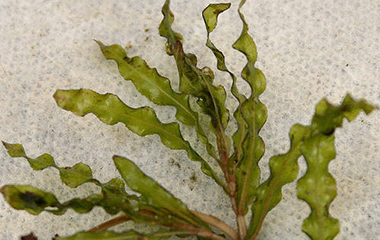Aquatic Plant Management
Aquatic Plants

Aquatic plants include larger plants, or macrophytes, and microscopic algae, or phytoplankton. These are the primary producers in the aquatic food pyramid. Macrophytes and phytoplankton compete for the same nutrients in a lake, and therefore lakes with an abundant macrophyte community may not experience frequent algae blooms. Similarly, heavy growths of algae may prevent macrophytes from becoming established in a lake.
Although macrophytes and phytoplankton are important to the overall health of a lake, excessive and/or unwanted aquatic plant growth can disrupt the natural ecosystem, detract from the aesthetic quality of the lake, and interfere with such recreational lake uses as boating and swimming. Techniques available to control nuisance aquatic plants include chemical herbicides, mechanical harvesting, and lake bottom covers.
Aquatic Herbicides
Chemical treatment with aquatic herbicides is a short-term method of controlling heavy growths of aquatic macrophytes and algae. Chemicals are applied to the growing plants in either liquid or granular form.
The advantages of using chemical herbicides to control aquatic macrophyte growth are the relatively low cost and the ease, speed, and convenience of application. However, the disadvantages associated with chemical control may include the following:
- Although short-term, lethal effects of chemicals are relatively well known, potential long-term, sublethal effects, especially on fish and fish-food organisms, are relatively unknown.
- The elimination of macrophytes reduces their competition with algae for light and nutrients. Thus increased algae blooms may develop.
- Since much of the dead plant material is not removed from the lake, the nutrients contained in the plant material will later be released into the water. Decomposition of the dead plant bodies also consumes dissolved oxygen and increases the potential for fish kills.
- The elimination of macrophyte beds destroys important food cover, food sources, and spawning areas for desirable fish species.
- Adverse impact on other aquatic organisms may be expected. At the concentrations used for macrophyte control, Diquat has been known to kill the zooplankton Daphnia and Hyalella. Both Daphnia and Hyalella are important fish foods and Daphnia is a primary food for the young of nearly all fish species.
- Areas must be re-treated in the following season and weed beds may need to be retreated more than once in a summer.
- Many of the chemicals available are non-selective and non-target, desirable species are affected by the treatment.
Aquatic Plant Harvesting
Mechanical harvesting of aquatic macrophytes is conducted with specialized harvesting equipment, consisting of an apparatus which cuts four to six feet below the water surface and a conveyor system to pick up the cut plants to be hauled to shore.
Advantages:
- Harvesting removes the plants from the lake. The removal of this plant biomass will decrease the rate of accumulation of organic sediment.
- Harvesting removes plant nutrients, including nitrogen and phosphorus, which would otherwise re-fertilize the lake as the plants decay. In addition to the physical removal of nutrients, plant harvesting may reduce internal nutrient recycling.
- Repeated macrophyte harvesting may reduce the regrowth of certain aquatic macrophytes.
- Where dense growths of filamentous algae are closely associated with macrophyte stands, they may be removed simultaneously.
- The remaining macrophyte stalks after harvesting provide cover for fish and fish food organisms, and stabilize the bottom sediment from wind erosion.
- Selective macrophyte harvesting may reduce stunting of panfish in lakes where excessive cover has influenced predator-prey relationships.
- The cut plant material may be used as mulch.
Disadvantages:
- Harvesting is most effective in water depths greater than two feet. Large harvesters cannot operate in shallow water or around docks or buoys.
- The reduction of aquatic macrophytes by harvesting reduces their competition with algae for light and nutrients. Thus, increased algae blooms may develop.
- Fish as well as fish prey organisms are frequently caught in the harvester.

